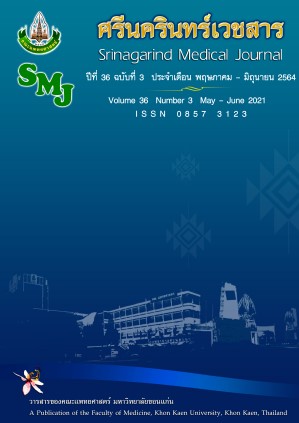แนวทางการปฏิบัติการให้ยาฉีดมอร์ฟีนใต้ผิวหนังที่บ้านของผู้ป่วยระยะท้าย
Abstract
หลักการและวัตถุประสงค์: การบูรณาการระบบการดูแลผู้ป่วยระยะท้ายแบบประคับประคองเข้าไปในนโยบายระบบสุขภาพแห่งชาติของประเทศไทยยังอยู่ในระยะเริ่มต้น การมียามอร์ฟีนใช้อย่างเพียงพอและสามารถเข้าถึงได้ นับเป็นองค์ประกอบสำคัญในการพัฒนาคุณภาพการดูแลแบบประคับประคอง ดังนั้นการศึกษานี้จึงมีวัตถุประสงค์ เพื่อพัฒนาแนวทางการปฏิบัติการให้ยามอร์ฟีนใต้ผิวหนังผู้ป่วยระยะท้ายที่บ้านโดยใช้เครื่อง syringe driver
วิธีการศึกษา: แนวทางการปฏิบัตินี้พัฒนาจากการทำงานร่วมกันระหว่างแพทย์ พยาบาลของศูนย์การุณรักษ์ และเภสัชกรในโรงพยาบาลศรีนครินทร์ มีการประชุมและกำหนดนโยบายร่วมกัน ได้แก่ ผู้ที่สั่งยาฉีดมอร์ฟีนให้ผู้ป่วยระยะท้ายนำกลับไปใช้ที่บ้านได้คือแพทย์ในศูนย์การุณรักษ์เท่านั้น ผู้ป่วยที่จำเป็นต้องใช้ยาฉีดมอร์ฟีนที่บ้านจะได้รับยาต่อเนื่องโดยการใช้เครื่อง syringe driver ครอบครัวจะได้รับการสอนเรื่องการใช้เครื่องมือโดยพยาบาล และได้รับอนุญาตจากเภสัชกรให้เบิกยากลับไปใช้ที่บ้านได้ 3-7 วัน พยาบาลทำหน้าที่ในการส่งต่อเครือข่ายประคับประคองใกล้บ้าน ติดตามให้ผู้ป่วยได้รับการดูแลต่อเนื่องที่บ้าน ครอบครัวสามารถเข้าถึงคำปรึกษาได้ 24 ชั่วโมง มีพยาบาลชุมชนที่อยู่ใกล้บ้าน ทำหน้าที่ในการเตรียมยาให้ผู้ป่วยทุกวันตามแผนการรักษาของแพทย์การุณรักษ์ พร้อมลงบันทึกการเตรียมและการให้ยาลงในสมุดประจำตัวการใช้ยาทางใต้ผิวหนังของผู้ป่วยแบบประคับประคองทุกวัน นอกจากนี้ยังทำหน้าที่ในการเยี่ยมบ้านผู้ป่วยที่นำยาฉีดมอร์ฟีนกลับไปใช้ที่บ้านทุกราย จนกว่าผู้ป่วยจะเสียชีวิต ภายหลังผู้ป่วยเสียชีวิตแล้ว ครอบครัวจะนำเครื่อง syringe driver และขวดยาฉีดมอร์ฟีนฉีดทั้งที่ใช้แล้วและไม่ได้ใช้มาส่งคืนที่ศูนย์การุณรักษ์ พยาบาลศูนย์การุณรักษ์และพนักงานการแพทย์ที่ได้รับมอบหมายให้รับผิดชอบโปรโตคอลนี้ นับจำนวนยาและตรวจสอบความถูกต้องของขนาดยาที่ใช้จริง ถ้าถูกต้องจะนำยาที่เหลือทั้งหมดส่งคืนให้กับเภสัชกรที่รับผิดชอบงานด้านการดูแลผู้ป่วยแบบประคับประคอง ของโรงพยาบาลศรีนครินทร์ จากการใช้โปรโตคอลนี้ส่งผลให้ผู้ป่วยระยะท้ายในระยะใกล้เสียชีวิตสามารถกลับบ้านได้ ไม่ทุกข์ทรมานจากอาการไม่สุขสบายก่อนเสียชีวิต ระยะเวลาในการเข้ารับการรักษาในโรงพยาบาลสั้นลง จึงได้มีการนำแนวทางการปฏิบัตินี้ไปขยายผลใช้กับโรงพยาบาลทุกแห่งในเขตบริการสุขภาพที่ 7
ผลการศึกษา: พบว่ามีผู้ป่วยระยะท้ายที่นำยาฉีดมอร์ฟีนกลับบ้านโดยใช้เครื่อง syringe driver ในปี พ.ศ. 2558 – 2561ตามลำดับ ร้อยละ 30.52, 34.85, 42.49 และ 11.19 ตามลำดับ ภายหลัง 3 ปี ที่มีการนำแนวทางการปฏิบัตินี้ไปขยายผลอบรมแพทย์และพยาบาลที่รับผิดชอบงานด้านการดูแลผู้ป่วยแบบประคับประคอง พบว่า ร้อยละ 76.1 ของโรงพยาบาลในเขตบริการสุขภาพที่ 7 มีการให้ยาฉีดมอร์ฟีนที่บ้านโดยใช้เครื่อง syringe driver และพบว่า ร้อยละ 98.5 มีนโยบายในการอนุญาตให้นำยาฉีดมอร์ฟีนกลับไปใช้ที่บ้านผู้ป่วยได้
สรุป แนวทางการปฏิบัตินี้ ช่วยทำให้ทีมสุขภาพมีความมั่นใจในการให้ยาฉีดมอร์ฟีนที่บ้านของผู้ป่วยระยะท้ายในระยะใกล้เสียชีวิตได้ จำนวนผู้ป่วยระยะท้ายที่ปรึกษาศูนย์การุณรักษ์ร่วมดูแลมีจำนวนการใช้ยามอร์ฟีนฉีดที่บ้านลดลง เนื่องจากเครือข่ายมีการนำแนวทางการปฏิบัตินี้ไปใช้มากขึ้น
คำสำคัญ ยาฉีดมอร์ฟีน; การให้ยาฉีดมอร์ฟีนใต้ผิวหนังผู้ป่วยระยะท้ายที่บ้าน
Background and Objectives: Palliative care in Thailand is still in an early integration into the national health care system. Morphine availability is an essential component in quality palliative care.
The objective of this study is to develop a strict protocol for using morphine injection via syringe driver in dying patients at their home.
Methods: This protocol was developed after joint meetings with hospital pharmacists. Palliative care doctors are the only doctors to prescribe morphine injections to be used at home. Patients who require morphine injections at home will be visited by Karunruk Palliative Care Center (KPC) team or by the community nurses near their home. The amount of morphine injection allowed per prescription is 3-7 days dosage. The community nurses will prepare the medication in a syringe according to the order from KPC, and the family will connect it via a syringe driver. The community nurses who prepare the medication record the exact amount of morphine injection used and sign daily in the booklet provided by KPC. When the patient dies, the family will return the syringe driver and the unused morphine injections to KPC. The palliative care nurse will validate and record the number of used and unused morphine ampules and return them to the hospital pharmacists. This protocol was introduced to all the hospitals in Health Service Area 7.
Results: The results of the study revealed as following:Have obtained syringe drivers to be used at home and percentage of morphine injections to be used in the patients’ home are 30.52, 34.85, 42.49 and 11.19 (sort by 2015-2018). After 3 years of protocol implementation coupled with intensive health professional education by KPC, now 76.1% of the hospitals in Health Service Area 7 have obtained syringe drivers to be used at home and 98.5% of these hospitals have changed their policies to allow morphine injections to be used in the patients’ home.
Conclusion: This protocol created confidence for the health care providers and enables morphine injection to be used at home in dying patients. The number of palliative care patients of Karunrak Center reduces morphine injections at home because the network has adopted this protocol more.
Keyword: Morphine injection; Morphine subcutaneous administration at home; Palliative care


